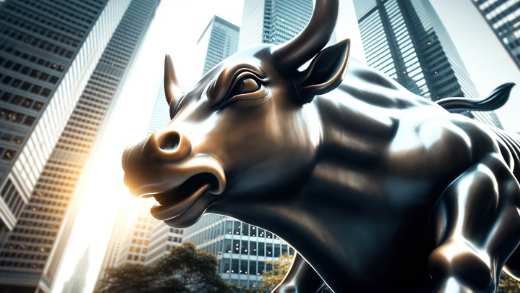In a world where potential pitfalls loom around every corner, Peter Fitzgerald and Ian Pizer explain why investors need to look beyond what financial models are telling them to keep portfolios resilient to the challenges ahead.
Read this article to understand:
- Why US rate cuts may be further away than expected
- Why investors need to be pragmatic, limit risk, and trade positions more actively
- Why fears of a US debt default appear overblown
As the focus on US regional banks intensifies, financial markets are becoming convinced US interest rates have peaked. Expectations are high the Federal Reserve will prioritise supporting economic growth and markets are pricing in a roughly even chance US rates will start falling as soon as June.
However, the fact core inflation is proving far stickier than many had anticipated is complicating the task facing the central bank in a manner not seen since the 1970s. Throw concerns around the “risk-free” status of US government bonds into the mix and the outlook for financial markets is highly uncertain, no matter how clichéd it may be to say so.
Peter Fitzgerald (PF) and Ian Pizer (IP), managers of our AIMS Target Return strategy, tell us why investors need to be humble in 2023, keeping an open mind and trading positions more actively in response to market gyrations.
You have expected inflation to remain stickier than markets anticipated for some time. Have you begun to express this view more strongly within the portfolio?
IP: As you get towards the end of the economic cycle, you have got to be more aware of the potential for the market to anticipate a turn. You might get one or two more rate hikes, but you have to make sure that you are not overstaying your welcome on those trades.
We traded from a short bias on rates, but as the market began to price in more hikes, we moved back towards a neutral position and rely more on relative-value trades.
As you get towards the end of the economic cycle, you have got to be more aware of the potential for the market to anticipate a turn
We have been running a position that will benefit from rates rising more in Europe than the UK, aware this would leave us less exposed in the event there were a big external shock, such as happened with the crisis in US regional banks.
While the Fed might be hiking for most of the rest of the year, if inflation is sticky, and US rates end up at six per cent, that is a trade that probably rewards you slowly. By contrast, rate expectations could fall quite dramatically, as we saw with the collapse of Silicon Valley Bank (SVB), so it is dangerous to play the trade aggressively. We are trying to ensure the portfolio can eke out some return without leaving us overly exposed to the risk of an exogenous shock.
PF: You potentially make money slowly and lose it very quickly. While we disagree with the idea rates will fall sharply from here, the challenge is that you will lose a lot more if you are wrong than you will make if you are right.
IP: You may not even be wrong, but the market might be willing to price a more aggressive rate cycle than you are able to hold your position through. The likelihood, particularly post SVB, that the market is going to price in aggressive hikes from the Fed is slim. Were that level of rates to be reached, it is far more likely the market would only be willing to price those hikes one at a time, always incorrectly believing that each move will be the last.
But if the market gets spooked for any reason, you may be sitting on a big loss, even if your view is ultimately right. What makes trading in the rates market even harder is the high level of spikes in volatility. For example the size of the move in two-year rates post SVB was as big as anything seen in 2008.
What do you put that down to?
IP: Illiquidity. Market makers’ risk tolerance is way down on where it was in 2008.
PF: Not only are investment banks’ balance sheets smaller, but hedge funds’ are bigger. It does not take much for several hedge funds to try to change their positions to effectively move the market.
Are rates close to peaking?
IP: You have to be more humble in this cycle than previously. The economic models that tell us inflation will fall this year are the same ones that told us inflation was going to fall last year and the same ones that told us it was transitory. Something appears to have changed but you cannot pinpoint what it is.
You have to be more humble in this cycle than previously
We can see headline inflation is coming down and a little softness in the labour market. But we have not seen a proper inflationary spike since the 1970s when the world was so different. In that environment, even when the economy looked weak and inflation looked like it was coming off sharply, it was easy to reignite it. We do not know if that is going to be the case now. Your central case is that inflation will come off, but your conviction in the models is weaker.
Where do you see inflation heading to?
PF: We see headline US inflation coming back down to about 3.5 per cent later this year. But the trend in core inflation is less clear, particularly in Europe. Whereas globalisation was deflationary, the reverse is now happening. So, instead of having a deflationary tailwind, you've got an inflationary headwind against asset prices.
IP: In the US and UK core inflation appears to have peaked and stabilised and there are hopes it is starting to edge down but it has not stabilised yet in Europe. Looking further ahead, while some people think once we come through this cycle we return to the old world of persistently low inflation, we are not in that camp.
What does being humble mean in terms of overall positioning?
IP: We thought UK rates looked attractive relative to European rates after the turmoil of last autumn subsided. As it turns out, we made more money on the UK leg, partly because we traded it more actively, but you are looking to be a little bit more pragmatic and limit your overall exposure. That way, in the event something unexpected happens, the portfolio is less dependent on getting the big call right.
Have we moved into a world where the holding period for trades needs to be shorter?
PF: It has been shorter, but not just the holding period. We have been short US rates for the bulk of the last 18 months, but we have traded that position much more actively as market pricing changed.
Equity markets have proved resilient in recent weeks. Why is this?
PF: Our view was that this was not a systemic banking crisis, as the banking industry is much more robust [than it was in the global financial crisis]. Whereas a lot of commentators maybe didn't see through that, markets broadly have thanks to the speed of reaction of policymakers.
Inflation is going to be a problem without a recession. And, if you get a recession, it is not good for risk assets
Having said that, inflation is going to be a problem without a recession. And, if you get a recession, it is not good for risk assets. There appears to be a false narrative that in a slowdown the Fed will not have to continue to raise rates; it might even be able to cut them, and therefore risk assets can continue to rally. Such a Goldilocks scenario appears unlikely.
IP: Equities traditionally peak around two months before the start of a recession. Although many think we need to see a recession to get inflation down, and while that may be bad for equities, historically the market has waited for a clearer sign of a downturn.
The trouble is everyone has already moved to the sidelines. The number of investors cheering this rally are few and far between. It has been an unloved rally. That may continue for a while longer. Some investors are buying back in, but not comfortably.
Are rising rates likely to cause problems for other sectors beyond banking?
IP: Everyone is talking about commercial real estate, but it had been under pressure for a while. The most rate-sensitive parts of the market have already taken a hit and we expect more of a slow bleed from here rather than some massive crack.
The other area at risk is small to medium-sized US businesses reliant on bank funding rather than capital markets, particularly away from the large cities. We don't expect a sudden stop in credit provision, but it is going to be harder to come by. As much as the large banks are benefitting from deposit inflows, they are not set up to serve these companies.
PF: The areas still vulnerable are those with business models that are not necessarily profitable and require continuous capital raising to fund ongoing expenditures. If you have a business that is not cashflow positive and is required to raise capital to continue to fund its expansion, it is likely to come under pressure.
Is there any risk of the US government defaulting given the impasse over increasing the $31.4 trillion borrowing limit, or is this a storm in a teacup?
IP: It could be messy and there may well be some level of government shutdown, but it is unlikely any coupon payments will be missed. It is still worth thinking through the implications of a missed coupon or redemption. Were this to happen, the risk that the payment is not made at a future date is as close to zero as you can get. Essentially, not only would the recovery rate be 100, but all missed interest payments would be made too. Although it may create an odd shape to the Treasury-bill curve, we do not believe this implies US Treasuries are at risk of losing their ‘risk-free’ status.
We do not believe this implies US Treasuries are at risk of losing their "risk-free" status
A government shutdown and the possibility of delayed payments to households and businesses could hit the economy at a time when it is vulnerable. In all likelihood, equities are far more vulnerable to this and, perversely, Treasuries are actually far more likely to rally.
It is worth remembering that when the UK was first considered to be at risk of losing its AAA status, there were similar concerns regarding investment mandates written when this wasn't thought a possibility. In the end, when it did get downgraded, the impact was minimal. Gilts remain considered within mandates and the market as the risk-free sterling asset of choice.

















